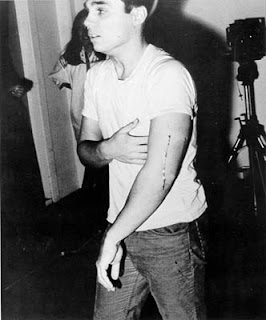 |
| Artist Paul McCarthy with J. Shimon after McCarthy's lecture at The Art Institute of Chicago, May 2012. Photographed by J. Lindemann |
A person definitely gets over meeting famous artists after being hired to photograph them by the dozens. There was one remaining exception, a single artist who seemed to rise above, Paul McCarthy. Our friend John McKinnon organized a talk at the Art Institute of Chicago last May (2012), and somehow intuitively knew we needed to connect. It was a rather conventional artist's talk, focused on more obscure works and maybe with a thicker than normal air of discomfort with the action of speaking about oneself. A handful of people came on stage to get various things signed, rather quickly leaving Paul standing alone. I approached him, we started out laughing, had a short, abstract conversation about holes/passages, barriers/containment, voids/hollowness, and began weeping. Julie immediately intervened and asked him why he quit teaching. "Didn't want to become one of those" was his reply. Yea, that is an issue isn't it. A contemporary art member/MBA/golfer type then whisked Mr. McCarthy away to the special VIP fundraiser dinner. Such is the life of a visionary artist.
 |
| Paul McCarthy lecture opening slide at The Art Institute of Chicago, May 2012. |
The New York Times Magazine ran a feature on McCarthy's work on May 10, 2013 titled:

















